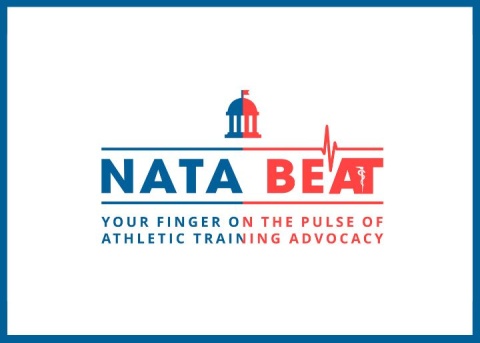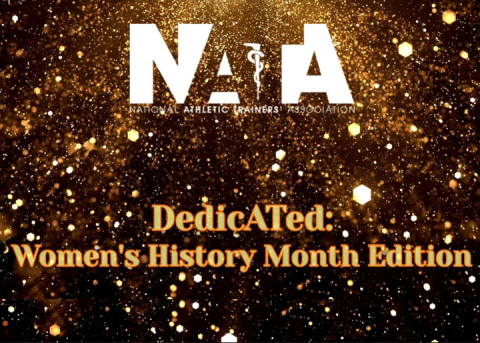
Last week’s Mental Health Awareness Month blog discussed the prevalence of diagnosable mental health disorders among adolescents and college-aged students. This week’s blog will look at the tools available to help athletic trainers care for athletes of any age who are dealing with a mental health concern.
During his Youth Sports Safety Summit (YSSS) presentation, “Mental Health Concerns and Strategies for Student Athlete Wellness,” Tim Neal, MS, AT, ATC, said recognizing a mental health issue may require athletic trainers to change the way they think.
“If you have an athlete who is experiencing bursts of anger, the questions shouldn’t be, ‘Why did he or she do that?’ but rather, ‘What happened to him or her to make them do that?’” he said. “Talk with them, and see if they have any underlining issues.”
Performance issues should also be considered, said NCAA Chief Medical Officer Brian Hainline, MD, during his Collaborative Solutions for Safety in Sport (CSSS) National Meeting presentation, “The Mental Health Landscape in Sport.”
“We have to differentiate performance issues from anxiety or depression issues,” Hainline said. “Sometimes, when someone is always choking at the free-throw line, we may think it’s a performance issue, but it may be much darker and deeper than that. We have to look at the difference between simple performance issues and real mental health concerns.”
When an athletic trainer approaches an athlete who they suspect of having a mental health issue or crisis, Neal recommends the 45-degree approach, which is more engaging than sitting side-by-side and less intimate that a face-to-face conversation.
“You’re not in their space, but you’re paying more attention than sitting next to someone, like when you’re driving,” he said. “It offers a zone of comfort to a person who is uncomfortable.”
When talking to someone who is suicidal, Neal said to talk “T.I.P.A” – thoughts, intention, plan and access.
“Don’t dance around the issue, ask them directly,” he said. “Many don’t want to die; they just want their pain to go away. And they want to know that someone is listening to them.”
Neal also advises athletic trainers to get to know the school nurse, guidance counselors and school psychologist. They should also become familiar with the school’s mental health referral and emergency referral plans.
“Follow your school district’s protocol,” he said, adding that ATs should seek assistance if they’re unsure of the proper procedure.
Hainline echoed the importance of having protocols and plans in place to handle any mental health situation.
“There must be an emergency action plan for student athletes who are acutely psychotic, suicidal, paranoid, are in a confused state or are acutely intoxicated or suffering from a drug overdose,” he said. “There must be an action plan that is rehearsed, and everyone should know how to make routine mental health referrals.”
The NCAA created the “Inter-Association Consensus Document: Best Practices for Understanding and Supporting Student Athlete Mental Wellness,” which is endorsed by NATA, to address the numerous mental health issues facing today’s student athletes. The document covers four cornerstones:
- Clinical licensure of practitioners providing mental health care
- Procedures for identification and referral of student athlete to qualified practitioners
- Pre-participation mental health screening
- Health-promoting environments that support mental well-being and resilience
The document also includes information on disordered eating and substance abuse, two topics of discussion during YSSS and CSSS.
Disordered Eating
“When we talk about disordered eating in our athletes, we’re looking at not just females, but also males,” said Cindy Chang, MD, during her CSSS presentation, “Disordered Eating, Energy Balance and Language Appropriate for Student Athletes.” “We’re talking about certain sports that are at risk and we’re also talking about sports you would never think about being at risk.”
Chang said there is a spectrum for eating disorders, and certain comorbid psychological disorders – such as mood, anxiety and oppositional defiant disorders – are also associated with disordered eating. The spectrum of eating disorders which includes:
- Anorexia nervosa: Excessive dieting that leads to extreme weight loss; primarily affects adolescent girls and young women
- Bulimia nervosa: Episodes of binge eating and recurrent inappropriate compensatory behavior, such as self-induced vomiting, misuse of laxatives, diuretic and other medications, fasting and excessive exercise; can be harder to recognize because often times those suffering are at normal weight, slightly underweight or slightly overweight
- Binge eating disorder: Recurring episodes of eating significantly more food in a short period of time than most people would eat; is similar to bulimia nervosa, but without purging, fasting, excessive exercising or laxatives
“There are reports that by the age of 8, [more than] 60 percent of girls have already commented on their weight or have tried to diet to lose weight,” Chang said. “By the age of 11, it’s up to 80 percent.”
Often times disordered eating is a response to pressure to change one’s appearance or optimize performance. Psychological factors, such as low self-esteem, poor coping skills, perceived loss of control, perfectionism, obsessive compulsive traits, depression, anxiety, history of sexual/physical abuse and family dysfunction, can also contribute to disordered eating.
Chang said there are several desirable characteristics athletes have – such as being goal oriented, a perfectionist, driven and people pleasing as well as having obsessive-compulsive tendencies and a high pain tolerance – that also fall into the symptomology of disordered eating.
“Other factors that are unique [to athletes] is a size increase due to weight training, the stress of being in the spotlight and balancing multiple role demands as an athlete, a student, a boyfriend, a girlfriend, etc.,” Chang said. “Lastly, a coach’s or parent’s comment about an athlete’s weight or appearance [can set off an eating disorder].”
Chang said signs of disordered eating include:
- Physical signs: Excessive/frequent fluctuations in weight; stress fractures and overuse injuries; cramping, weakness, fatigue, achiness; dizziness, fainting; broken blood vessels in eye; sore throat, swollen salivary glands; cold intolerance; constipation; tooth decay, receding gums
- Behavioral signs: Restricted food intake, becoming a “picky” eater; eliminating specific foods or whole food groups; fear of food, avoiding social situations involving food, solo eating; excessive exercise, above expected sport training; regular weighing; frequent comments about own weight, calories, food fat content; frequent bathroom visits following meals; moodiness, withdrawal from others
- Attitudinal signs: Dichotomous thinking, a tendency to only see extremes (good or bad, black of white, all or nothing); denial of eating problems, perfectionistic standards, fear of failure, harsh self-criticism, self-worth determined by weight
“If you can’t control your weight or appearance, then you feel very, very frustrated,” she said.
Athletic trainers are in unique positions because of their close relationships with athletes. Chang offers the following tips to athletic trainers when they encounter athletes with possible disordered eating:
- Don’t question teammates or talk to them about the athlete. Talk directly to athlete.
- Don’t ignore the problem – intervene.
- Don’t get into a power struggle about whether there is a problem.
- Don’t be deceived by excuses.
- Never conclude that an athlete just isn’t trying hard enough to overcome an eating disorder.
- Don’t try to keep the problem hidden or try to deal with it yourself.
- When in doubt, refer out.
“Prevention wise, don’t focus on weight or appearance,” Chang said. “Often times, it is an inadvertent comment that makes them go over the edge.”
She also recommends eliminating weigh-ins, especially those done by coaches, and develop a mental health care network, like the one created by the NCAA.
Substance Abuse
Something health care professionals need to consider when caring for an athlete – or any individual – in a mental crisis is the medications they take, particularly any opiates or opioids.
“At the NCAA level, about a quarter of the kids are arriving on medications, ranging from stimulants to anti-depression to anti-anxiety to more,” Hainline said. “And a number of them are taking medications off label. We know that at least 12 percent of the kids are using stimulants off label. We know that at least 18 percent of NCAA student athletes are using prescription opiates, meaning OxyContin, Percocet, Vicodin.”
He added that opiates need to be considered psychotropic drugs because they make users unable to feel pain on any level of their being.
Jennifer Weiss Burke, executive director of Healing Addictions in Our Community and Serenity Mesa Youth Recovery Center in Albuquerque, New Mexico, said during her YSSS presentation, “Opiate Abuse Among Teenage Athletes: What You Need to Know,” that after taking opiates for 10 days, the brain begins to change and addiction begins.
“Heroin and prescription pain killers are closely tied together,” she said, adding that 90 percent of heroin addicts start with an addiction to pain killers. “The line between use, misuse, abuse and addition is incredibly thin.”
Since 2000, drug overdoses in the United States have increased 137 percent, with the majority of overdoses due to opiate pain killers and heroin, Burke said. She added that addicts nowadays don’t fit the stereotypical profile of what a heroin user should look like, and drug abuse has infiltrated communities and neighborhoods that previously never had a problem.
“We want quick fixes, and there is a pill for everything now. Our kids are raised in this environment,” she said, adding that at times doctors aren’t informed about the drugs they’re dispensing or they’re not communicating their potential risks to families.
Athletes, especially young athletes, are particularly at risk because they encounter strong pressure to manage their pain and play through injuries.
“They’re given opioids, and if not monitored or aware of the potential dangers, they’re at risk of being addicted,” said Neal, advising athletic trainers to conduct drug tests if they encounter an athlete who appears to be sick, but they can’t find anything wrong with them.
Burke said when it comes to opiates and potential addiction, knowledge is power.
“Pain killers aren’t the devil,” she said. “But you need to educate yourself, your kids and your athletes. … Don’t think it can’t happen to you.”
Burke said it’s important to know the warning signs of an opiate addiction, including:
- Behavioral signs: Change in attitude; loss of interest in things they used to care about; not wanting to hang out with family and friends; change of friends; drastic mood swings; always needing money; and disappear or are hard to get ahold of
- Physical signs: Pinpoint pupils; losing weight; change in sleep patterns; runny nose; nodding off; scratching; finding pieces of tin foil or circle cut outs from shopping bags; finding hollow ink pens; and black marks on their face or the walls and light switches
Perhaps the most important thing and athletic trainer can do when dealing with someone with a drug addiction is not judge them.
“This is a disease, not a moral failure,” Burke said. “If you suspect someone is addicted, talk to them and try to get them help.”
Resources
NATA has dedicated an entire page of its “Practice & Patient Care” section of its website to mental health resources available to athletic trainers. This includes the “Preventing, Detecting and Managing Disordered Eating in Athletes” position statement and the NATA consensus statements “Developing a Plan to Recognize and Refer Student Athletes with Psychological Concerns at the Collegiate Level” and “Developing a Plan to Recognize and Refer Student Athletes with Psychological Concerns at the Secondary School Level.”
Next week’s mental health blog will examine how athletic trainers can care for themselves if they face a mental health issue or tragic event, such as the loss of an athlete or coworker.




